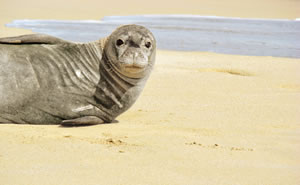Running Out Of Time To Save Seals

This fellow is believed to be one of just 1,100 Hawaiian monk seals still alive. Photo from Donna Lee
Charles Littnan is leading the fight to keep Hawaiian monk seals from joining the list of extinct species
Hawaiian monk seals have finally hit the national stage. The question is whether it’s too late to do them any good.
“This is the biggest out-reach for the monk seal in history,” says National Oceanic and Atmospheric Administration’s Hawaiian Monk Seal Research Program lead scientist Charles Littnan during a recent presentation.
Held in conjunction with activities surrounding the release of the latest American Girl doll named Kanani Akina, who hails from Kaua’i, the showcase was part of a weeklong promotion by the Kaua’i Visitors Bureau.
“His knowledge of the Hawaiian monk seal’s biology and ecology is extensive, and his generous, inclusive attitude toward all stakeholders in the effort to save these animals is greatly admired,” says KVB executive director Sue Kanoho. “Combine all this with his access to the most current scientific information available, and he was the only choice for this presentation.”
Integrated in the plot of one of the books associated the 2011 American Girl doll, a Hawaiian monk seal that has been entangled in fish netting is rescued by Kanani.
It’s an all too familiar real-life conflict for the only endangered marine mammal that resides solely in the United States.
So the attention is very timely, Littnan says.
“And it’s not only reaching a national audience,
it’s reaching the next generation and the people who will be the decision makers and helping with monk seal conservation in the future,” he adds.
The name recognition, and knowledge of where the seals live and their level of endangerment has occurred on a much grander scale than we ever imagined, Kanoho says.
With only about 1,100 Hawaiian monk seals remaining on the planet, every effort to ensure their survival has to be taken, Littnan says.

NOAA’s Charles Littnan: ‘We’re not sitting idly’. Photo courtesy Charles Littnan
“We’re not sitting idly, we’re trying to fight this,” he says.
If matters are not taken into the hands of scientists like Littnan who is using the American Girl doll as an opportunity to spread mass awareness, by 2014 only 80 pups will be born and by 2021 a mere 32.
“We’re rapidly running out of time,” he says to a small audience including a few children late last month.
In the past 50 years, the Hawaiian monk seal population has declined by at least 70 percent and is predicted to drop below 1,000 within the next few years.
Not only is Kanani garnering mass media attention for the seal, attaching National Geographic critter cams to the marine mammal has also been a successful way of broadening knowledge and helping researchers like Littnan better understand the endangered species.
Without them, for example, scientists may not have so easily discovered the ways in which the sea creatures collect food at the bottom of the ocean floor or the depths of more than 1,600 feet they are capable of diving.
“We very quickly realized we were underestimating the capacity of the seals,” he says while showing the audience footage of monk seals foraging for fish under rocks, all while large competitors like ulua and shark await the chance to steal it away.”
In fact, competition is likely why juveniles are struggling in the Northwestern Islands, as they are not as skilled as their adult counterparts, he explains.
Scientists have also observed that seals, capable of eating roughly 15 pounds of food a day, never fish in one place for very long.
“Monk seals are excellent conservationists,”
Littnan says. “They are totally into sustainability.”
The species, which is thought to have begun its journey to the islands millions of years ago, now needs comparable human preservation efforts to survive on earth, he says.
But one of the best things people can do to help is simply respect their space, especially when the seals are seen resting on the shoreline.
“When they come out, it’s after hours, days or months at sea,” Littnan says. Disturbing them would be akin to someone jumping on your bed in the middle of the night.
“If you keep doing it, they won’t get their rest,” he says. “First and foremost, respect the seals.”



